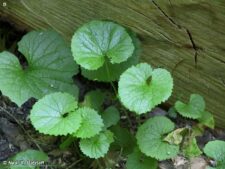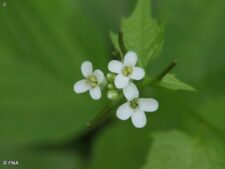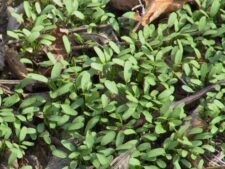
This biennial mustard was introduced from Europe. The first year tiny seedlings (D) emerge to cover the ground. They soon develop during that season into plants with kidney-shaped leaves (B). The second year erect stems up to 5 feet tall emerge. They hold terminal clusters of white, 4-petaled flowers (A,C). The fruit is a slender pod (silique) which holds many tiny black seeds.
Abundant, invasive and widespread at both Fontenelle Forest and Neale Woods. Flowering occurs from April to June.
First recorded in 1868 on the East Coast, this species has now spread to more than 38 States and parts of Canada as well. This invasive plant has spread explosively in Fontenelle Forest and Neale Woods during the past 20 years. In many parts it is now the dominant ground cover with a devastating effect on native plant species. There are on-going efforts to control its further spread. Introduction to North America is likely related to culinary use of its garlic-flavored edible leaves, unfortunately, a taste not shared by our forest deer who avoid it.
The content of NatureSearch is provided by dedicated volunteer Naturalists of Fontenelle Forest who strive to provide the most accurate information available. Contributors of the images retain their copyrights. The point of contact for this page is: Roland Barth.

 Identification
Identification

